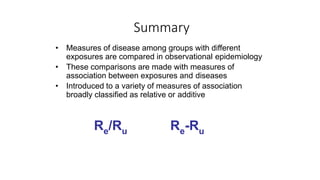
Measures of disease association in observational epidemiology
- 1. Summary • Measures of disease among groups with different exposures are compared in observational epidemiology • These comparisons are made with measures of association between exposures and diseases • Introduced to a variety of measures of association broadly classified as relative or additive Re/Ru Re-Ru
- 2. Summary • While the relative have been more commonly used, the additive have been argued to be better for purposes of identifying etiology and estimating public health impact • Insights from two of the theoretical causal models elucidate why this argument has been made, and elucidate what relative and absolute measures estimate
- 3. Summary Variety of terms used for measures of association discussed today • “Risk” often used generically to include rates (ID), risks (CI) and even prevalence
- 4. Summary Relative measures • Cumulative incidence ratio (CIR) • Incidence density ratio (IDR) • Prevalence ratio (PR) • Rate/risk ratio = Relative risk (RR) • Odds ratio (OR)
- 5. Summary Absolute measures • Attributable risk (AR) = Risk/rate difference = Excess risk • Population attributable risk (PAR) = Population risk/rate difference • Attributable risk percent (AR%) = Etiologic fraction = Attributable proportion among the exposed • Population attributable risk percent (PAR%) = Attributable proportion in the total population
- 6. Summary • Have only examined what are called “crude” measures of association – Compared exposed and unexposed populations without considering other variables that may differ between the populations – Later in the course we will discuss how to deal analytically with other variables that may be different between the exposed and unexposed and that thus make the populations not exchangeable (to be discussed in confounding)
- 8. Extra slides
- 9. Absolute measures • Alternative formulation: • PAR = (AR)(Pe) • Where does this come from? • PAR = Rt – Ru • PAR = [(Pe)Re + (1-Pe)Ru] - Ru • PAR = (Pe)Re + Ru - (Pe)Ru - Ru • PAR = (Pe)Re - (Pe)Ru • PAR = (Re - Ru)(Pe) • PAR = (AR)(Pe)
- 10. Causal perspective • When we estimate AR, PAR, AR% or PAR% (whether with counterfactual populations or in observational data) they will only provide a lower bound of the true incidence or fraction of inciden due to the exposure mechanistically (think of the pies) – unless exposure acts independent of background causes
- 11. Causal perspective Szklo Figure 3-1 Incidence caused by mechanism including exposure In absence of exposure, another causal mechanism (background cause) was completed within study time frame
- 12. Causal perspective Population unexposed for a given time period, population exposed over same period Rates/risks compared are causal p1+p3 p1+p2 Counterfactual Counterfactual
- 13. Causal perspective • Extreme example – mechanism including your exposure causes disease 1 day earlier than would have occurred otherwise from background causes • In the exposed, your exposure mechanistically caused 100% of disease • In your data the rate of disease appears the same in the exposed and unexposed and you infer 0% of disease caused by your exposure (ME3 p63, 297 for elaborated discussion) • Type 2 (slide 74) individuals (in this example 100% of them) had disease caused by exposure when exposed, but caused by another mechanism when not exposed • Thus incidence due to specific causal mechanisms cannot be estimated from epidemiologic data
- 14. Relative measures • OR – exposure OR vs disease OR – Exposure OR = odds(E|D)/odds(E|Dnot) – EOR = (a/c)/(b/d) = ad/bc – Disease OR = odd(D|E)/odds(D|Enot) – DOR = (a/b)/(c/d) = ad/bc – Exposure OR = disease OR